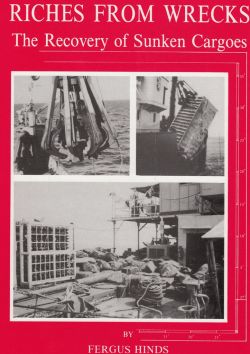
Riches from Wrecks
By Fergus Hinds
- Price:
- £30.00
Item attributes
- ISBN:
- 978-0-85174-623-4
- Published date:
- First Edition: 1995
Item details
Over the years there has settled on the scabed in the holds of sunken ships an enormous wealth in metals unspoilt by immersion in seawater, ranging from antimony and bismuth to uranium and wolfram. Of course there is gold and silver amongst them, but the bigger industrial cargoes far exceed in value most losses of bullion that history has ever seen. The thrill of pursuing them gets added zest from an unrelenting commercial pressure for continuous success for there is no fun in failing. Here is a book that illustrates the hitherto unpublicised business of recovering such cargoes.
Little has been written about it before because the principal asset of the salvors who brought them up were the details of their techniques, both afloat by their crews and ashore by researchers panning grains of valuable data from tons of dusty archives. But years of successes have so diminished what still stands in need of protection that past secrets can now be unveiled.
The technique was established by an Italian before World War 11, and much expanded by an Englishman named Risdon Beazley after it. The book starts with the English recovery of a ton of the Bank of England's gold-bullion from theEmpire Manor off Newfoundland, an endeavour spanning twenty years first to last. Part of its risk was funded by two remarkable First World War sinkings, one off the Faeroes the other - which took thirteen years to find - well south-west of the Scillies. Together these three ventures, with allusions to a few others, illustrate all the practical, commercial, and historical essentials of this exciting, chancy, and sometimes dangerous business.
There follows the salvage of more than £4 million from 1000 feet (320 metres) down in the Mediterranean, an effort in most respects a record. The account highlights the historical documentation vital in such cases, and the use which is made of it. The covert manoeuvring surrounding the recovery of the gold from H.M.S. Edinburgh leads on to some of the astonishingly sanguine efforts of numerous offshore oil companies spawned by that spectacular success. Hundreds of tons of gold, thousands of silver, even mysterious sinkings with unknown contents, still lure backers with ready millions.
These bizarre undertakings take the second part of the book to the largely lawless Far East where, apart from a ton of gold clandestinely taken up from the Japanese submarine I.34 sunk off Penang in 1944, the targets are the contents of Japanese wartime merchant ship losses. Millions from vast fortunes recovered have seeped away in the manner of those parts by mechanisms marvellous and devious, and the arrest of a salvage ship by communist Chinese for working in waters claimed by Taiwan had its moments of entertainment too.
The book closes, after a brush with an East Indian man showing how very doubtful are the prospects that sailing ships offer, with the real opportunities awaiting bold men in deep water.
This is a topic of fascination to all manner of mariners: by deliberately non-specialist presentation the glamour and fun of real-life treasure hunting may be relished by anyone.
Formerly a naval hydrographic officer, the author joined Risdon Beazley Ltd. in 1970; later he managed its cargo recovery activities, before shifting his attention out east.

